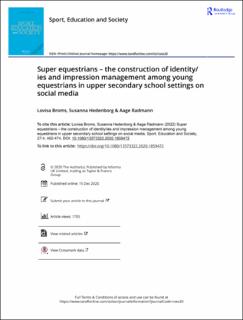| dc.contributor.author | Broms, Lovisa | |
| dc.contributor.author | Hedenborg, Susanna | |
| dc.contributor.author | Radmann, Aage | |
| dc.date.accessioned | 2022-05-27T14:16:48Z | |
| dc.date.available | 2022-05-27T14:16:48Z | |
| dc.date.created | 2022-03-30T17:25:33Z | |
| dc.date.issued | 2022 | |
| dc.identifier.citation | Sport, Education and Society. 2022, 27(4), Side 462-474. | en_US |
| dc.identifier.issn | 1357-3322 | |
| dc.identifier.uri | https://hdl.handle.net/11250/2996529 | |
| dc.description | This is an Open Access article distributed under the terms of the Creative Commons Attribution-NonCommercial-NoDerivatives License (http://creativecommons.org/licenses/by-nc-nd/4.0/), which permits non-commercial re-use, distribution, and reproduction in any medium, provided the original work is properly cited, and is not altered, transformed, or built upon in any way. | en_US |
| dc.description.abstract | The aim of this study is to analyze and increase the understanding of how young equestrians, in a sport school context, perceive, construct, negotiate and manage identities on social media. This article presents how a specific group of young athletes (equestrians) use social network sites (SNS), such as Facebook and Instagram, in relation to their everyday lives as students attending upper secondary schools with an equestrian sports profile. Social media is increasingly important for young people’s perceptions, constructions, and managing of identities. Using a multifaceted theoretical framework, including Erving Goffman’s dramaturgical perspective, we will explore how young equestrians perceive the content on SNS and analyze how they act and create content in relation to existing norms and cultures. Equestrianism is one of the largest sports in Sweden and several upper secondary schools in Sweden offer programs with an equestrian profile. Studies on sport schools evince a focus on elite sport and competition, which affects norms and ideologies at these schools. Through focus group interviews with 25 students, we show that the situation is complex and contradictory. The results indicate that young riders have identified an online stable culture where high performance equestrianism is the norm. Our study shows that the educational environment is not the only factor affecting the students, but that social media is also a part of the young athletes’ constructions of identity. The image of the employable ‘super equestrian’ who is attractive, wears the ‘right clothes’, is successful, and acts ‘professionally’ is the most desirable representation online. The young equestrians are critical of what is communicated on SNS in relation to horses and riding, and they are uncertain of how to position themselves in relation to this communication. | en_US |
| dc.language.iso | eng | en_US |
| dc.subject | equestrian sports | en_US |
| dc.subject | equestrianism | en_US |
| dc.subject | identity construction | en_US |
| dc.subject | impression management | en_US |
| dc.subject | school sport | en_US |
| dc.subject | social media | en_US |
| dc.subject | social network sites | en_US |
| dc.subject | upper secondary education | en_US |
| dc.title | Super equestrians: The construction of identity/ies and impression management among young equestrians in upper secondary school settings on social media | en_US |
| dc.type | Peer reviewed | en_US |
| dc.type | Journal article | en_US |
| dc.description.version | publishedVersion | en_US |
| dc.rights.holder | © 2020 The Author(s) | en_US |
| dc.source.pagenumber | 462-474 | en_US |
| dc.source.volume | 27 | en_US |
| dc.source.journal | Sport, Education and Society | en_US |
| dc.source.issue | 4 | en_US |
| dc.identifier.doi | 10.1080/13573322.2020.1859472 | |
| dc.identifier.cristin | 2013884 | |
| dc.description.localcode | Institutt for lærerutdanning og friluftslivsstudier / Department of Teacher Education and Outdoor Studies | en_US |
| cristin.ispublished | true | |
| cristin.fulltext | original | |
| cristin.qualitycode | 2 | |
